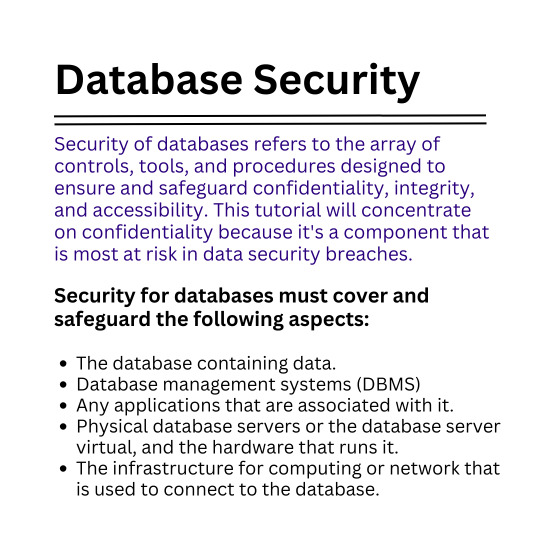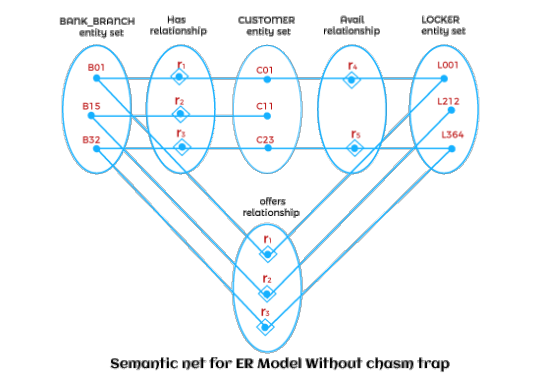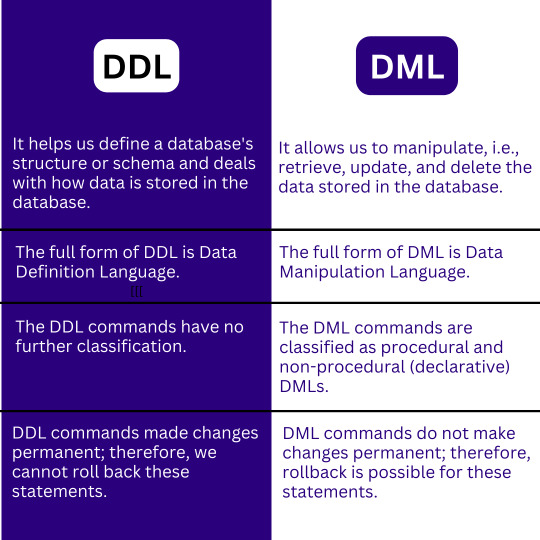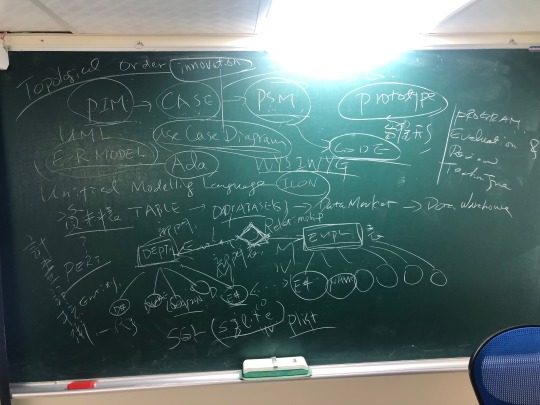#ERModeling
Explore tagged Tumblr posts
Text
Understanding ER Modeling and Database Design Concepts
In the world of databases, data modeling is a crucial process that helps structure the information stored within a system, ensuring it is organized, accessible, and efficient. Among the various tools and techniques available for data modeling, Entity-Relationship (ER) diagrams and database normalization stand out as essential components. This blog will delve into the concepts of ER modeling and database design, demonstrating how they contribute to creating an efficient schema design.
ER Modeling
What is an Entity-Relationship Diagram?
An Entity-Relationship Diagram, or ERD, is a visual representation of the entities, relationships, and data attributes that make up a database. ERDs are used as a blueprint to design databases, offering a clear understanding of how data is structured and how entities interact with one another.
Key Components of ER Diagrams
Entities: Entities are objects or things in the real world that have a distinct existence within the database. Examples include customers, orders, and products. In ERDs, entities are typically represented as rectangles.
Attributes: Attributes are properties or characteristics of an entity. For instance, a customer entity might have attributes such as CustomerID, Name, and Email. These are usually represented as ovals connected to their respective entities.
Relationships: Relationships depict how entities are related to one another. They are represented by diamond shapes and connected to the entities they associate. Relationships can be one-to-one, one-to-many, or many-to-many.
Cardinality: Cardinality defines the numerical relationship between entities. It indicates how many instances of one entity are associated with instances of another entity. Cardinality is typically expressed as (1:1), (1:N), or (M:N).
Primary Keys: A primary key is an attribute or set of attributes that uniquely identify each instance of an entity. It is crucial for ensuring data integrity and is often underlined in ERDs.
Foreign Keys: Foreign keys are attributes that establish a link between two entities, referencing the primary key of another entity to maintain relationships.
Steps to Create an ER Diagram
Identify the Entities: Start by listing all the entities relevant to the database. Ensure each entity represents a significant object or concept.
Define the Relationships: Determine how these entities are related. Consider the type of relationships and the cardinality involved.
Assign Attributes: For each entity, list the attributes that describe it. Identify which attribute will serve as the primary key.
Draw the ER Diagram: Use graphical symbols to represent entities, attributes, and relationships, ensuring clarity and precision.
Review and Refine: Analyze the ER Diagram for completeness and accuracy. Make necessary adjustments to improve the model.
The Importance of Normalization
Normalization is a process in database design that organizes data to reduce redundancy and improve integrity. It involves dividing large tables into smaller, more manageable ones and defining relationships among them. The primary goal of normalization is to ensure that data dependencies are logical and stored efficiently.
Normal Forms
Normalization progresses through a series of stages, known as normal forms, each addressing specific issues:
First Normal Form (1NF): Ensures that all attributes in a table are atomic, meaning each attribute contains indivisible values. Tables in 1NF do not have repeating groups or arrays.
Second Normal Form (2NF): Achieved when a table is in 1NF, and all non-key attributes are fully functionally dependent on the primary key. This eliminates partial dependencies.
Third Normal Form (3NF): A table is in 3NF if it is in 2NF, and all attributes are solely dependent on the primary key, eliminating transitive dependencies.
Boyce-Codd Normal Form (BCNF): A stricter version of 3NF where every determinant is a candidate key, resolving anomalies that 3NF might not address.
Higher Normal Forms: Beyond BCNF, there are Fourth (4NF) and Fifth (5NF) Normal Forms, which address multi-valued dependencies and join dependencies, respectively.
Benefits of Normalization
Reduced Data Redundancy: By storing data in separate tables and linking them with relationships, redundancy is minimized, which saves storage and prevents inconsistencies.
Improved Data Integrity: Ensures that data modifications (insertions, deletions, updates) are consistent across the database.
Easier Maintenance: With a well-normalized database, maintenance tasks become more straightforward due to the clear organization and relationships.
Benefits of Normalization
ER Modeling and Normalization: A Symbiotic Relationship
While ER modeling focuses on the conceptual design of a database, normalization deals with its logical structure. Together, they form a comprehensive approach to database design by ensuring both clarity and efficiency.
Steps to Integrate ER Modeling and Normalization
Conceptual Design with ERD: Begin with an ERD to map out the entities and their relationships. This provides a high-level view of the database.
Logical Design through Normalization: Use normalization steps to refine the ERD, ensuring that the design is free of redundancy and anomalies.
Physical Design Implementation: Translate the normalized ERD into a physical database schema, considering performance and storage requirements.
Common Challenges and Solutions
Complexity in Large Systems: For extensive databases, ERDs can become complex. Using modular designs and breaking down ERDs into smaller sub-diagrams can help.
Balancing Normalization with Performance: Highly normalized databases can sometimes lead to performance issues due to excessive joins. It's crucial to balance normalization with performance needs, possibly denormalizing parts of the database if necessary.
Maintaining Data Integrity: Ensuring data integrity across relationships can be challenging. Implementing constraints and triggers can help maintain the consistency of data.
Common Challenges and Solutions
Conclusion
Entity-Relationship Diagrams and normalization are foundational concepts in database design. Together, they ensure that databases are both logically structured and efficient, capable of handling data accurately and reliably. By integrating these methodologies, database designers can create robust systems that support complex data requirements and facilitate smooth data operations.
FAQs
What is the purpose of an Entity-Relationship Diagram?
An ER Diagram serves as a blueprint for database design, illustrating entities, relationships, and data attributes to provide a clear structure for the database.
Why is normalization important in database design?
Normalization reduces data redundancy and enhances data integrity by organizing data into related tables, ensuring consistent and efficient data storage.
What is the difference between ER modeling and normalization?
ER modeling focuses on the conceptual design and relationships within a database, while normalization addresses the logical structure to minimize redundancy and dependency issues.
Can normalization impact database performance?
Yes, while normalization improves data integrity, it can sometimes lead to performance issues due to increased joins. Balancing normalization with performance needs is essential.
How do you choose between different normal forms?
The choice depends on the specific needs of the database. Most databases aim for at least 3NF to ensure a balance between complexity and efficiency, with higher normal forms applied as necessary.
HOME
#ERModeling#DatabaseDesign#LearnDBMS#EntityRelationship#DataModeling#DBMSBasics#DatabaseConcepts#TechForStudents#InformationTechnology#DataArchitecture#AssignmentHelp#AssignmentOnClick#assignment help#assignment service#aiforstudents#machinelearning#assignmentexperts#assignment#assignmentwriting
0 notes
Text

Database Security . . . . for more information https://bit.ly/3XHGBZ5 check the above link
0 notes
Text

Struggling with ER Modeling or Normalizing Data for your assignment? Let me help you ace it! Get expert guidance and clear explanations for DATA4200 Data Acquisition and Management subject. DM us for details.
#ERModeling #DatabaseDesign #DataNormalization #AssignmentHelp #DBMS #DATA4200 #DataAcquisition #Management #ERModeling #NormalizingData #KaplanUniversity #KBS #Australia
0 notes
Text
第一級到第3級正規化和BCNF(Boyce-Codd Normal Form)[資料庫]-[三等資訊警察][資管所][國安資訊][調查局資訊科學][高普考資訊處理] #郭富 #roycekuo #資料庫 #MDA #ERModel #ERDiagram #PIM #CASE #PSM
第一級到第3級正規化和BCNF(Boyce-Codd Normal Form)[資料庫]-[三等資訊警察][資管所][國安資訊][調查局資訊科學][高普考資訊處理] #郭富 #roycekuo #資料庫 #MDA #ERModel #ERDiagram #PIM #CASE #PSM
臺 灣 警 察 專 科 學 校112 學年度甄選入學中央警察大學簡章; #警甄 #二技 #高見 #高鋒 #郭富 報名日期 112 年 1 月 3 日起至 112 年 1 月 18 日止,逾期不予受理。 https://bit.ly/3BWDa5h 臺 灣 警 察 專 科 學 校112 學年度甄選入學中央警察大學簡章; #高見 #高鋒 #郭富 111年資料庫應用考猜列表於國安調查局及高考題目之猜中驗證[郭富][roycekuo]YouTube[三等資訊警察][資管所][國安資訊][調查局資訊科學][高普考資訊處理] #郭富 #猜中列表 #資料庫應用 #111年 #roycekuo #高見…

View On WordPress
#MDA PIM CASE PSM EIP DFD UML ERD#111警察特考#case#ERDiagram#ERModel#郭富#郭富教學#調查局#警大資管所#資訊組#MDA#PIM#psm#國安局#三等警察特考#三等資訊警察
0 notes
Link

0 notes
Text
I can't believe they didn't call that soup can challenge "Soupy That Walk"
3 notes
·
View notes
Text
Bob mit Pony: Auswahl einiger super stylish Modelle #auswahl #dekoration #de…
Bob mit Pony: Auswahl einiger super stylish Ermodels #auswahl #dekoration #de… , #Auswahl #Bob
Struktur des Haares
Haar ist eine Art von Protein namens Keratin. Dank Disulfid-, Öl- und Wasserstoffbrückenbindungen hat es eine dauerhafte Struktur. Die haltbarste Schicht ist die äußere Schicht. Es gibt mir das Pigment von Melanin in der Farbe der Haare. Die Menge an Melaninpigment liefert verschiedene Farben. Der Haartyp (gerade-lockig) wird durch die Dichte der Disulfidbindungen bestimmt. Disulfidbindungen sind bei lockigem Haar intensiver. Obwohl das Haar dünn ist, ist es vielschichtig und besteht aus mehreren Fasern. Eine Bifurkation am Haar tritt auf, wenn diese Strukturen getrennt werden. Innerhalb der Follikeleinheit in der dermalen Papille bilden sich Haare, die sich von der Epidermis, der obersten Hautschicht, bis zur Dermis erstrecken. Dann streckt es sich aus, durchbohrt die Epidermis und kommt heraus. Obwohl sich die Haarstrukturen in anderen Körperteilen unterscheiden, ist die allgemeine Grundstruktur eng.
Das Stahlstruktur-Keratin
Innerhalb der Follikeleinheit in der Dermalpapilla bilden sich Haare, die sich von der Epidermis, der obersten Hautschicht, bis zur Dermis erstrecken. Dann streckt es sich aus, durchbohrt die Epidermis und kommt heraus. Das Haar entsteht durch die Sekretion von Zellen im Bulbus-Teil, der als Wurzel bezeichnet wird, und durch Multiplikation und Veränderung der Struktur. Es wird in Richtung Hautoberfläche gedrückt. Haarausfallgründe wie die Bildung von Haaren sind in diesem Abschnitt ebenfalls wirksam. Nämlich; DHT (Di Hydro Testosteron), das die Zellen schädigt, die die Produktion in der Haarwurzel bewirken, besteht aus Testosteron in der Talgdrüse, die die Wurzel schmiert. Medikamente, die die DHT-Bildung verhindern, verhindern auch die DHT-Bildung, indem sie die 5-Alpha-Reduktase in dieser Region hemmen.
from WordPress https://demo.tatowierungens.com/?p=53053
0 notes
Text

DDL vs. DML . . . . for more information https://bit.ly/4bqte2A check the above link
0 notes
Text

ER Model vs. Relational Model . . . . for more information https://bit.ly/3W4Gjuc check the above link
0 notes
Text
[資訊管理系統共同課程][MDA-ModelDrivenArchitecture][郭富老師][UML-DFD-ERModel] #roycekuo #郭富
https://kuofu.shop 10/23 警專高見。郭富現埸講座 可參加問問題。許多網路聼不到的東西 分享給你 – 郭富(三等資訊警察、資管所、國安資訊、調查局資訊科學、高普考資訊處理 (kuofu.shop)
https://player.soundon.fm/p/06bb22d4-c774-4b6d-80cf-f940c70c264a/episodes/f66a9548-06c6-42bb-b1ee-8ab865d1d094 郭富三等資訊警察、資管所、國安資訊、調查局資訊科學、高普考資訊處理(考試諮詢表) https://docs.google.com/forms/d/e/1FAIpQLSfRohLBXmb98BlAzDtErbYCi0VcSYcYTj_HkyhO0xk3nJcIUg/viewform?usp=pp_url podcast https://kuofu1001202.wordpress.com/2021/12/21/podcast-podcast/ 郭富 youtube…

View On WordPress
0 notes
Text

#DataWarehouse #relationalDatabase #DBMS #transaction #schema #ERmodel #structuredquerylanguage
0 notes
Photo

必考時事考點_三等警察特考專業科目範圍分析plus110年警政資訊管理系統與應用plus 資訊管理系統共同課程一系列必懂-SDLC, PIM, CASE, PSM, ERP, MDA, DATAMINING, UML, ERMODEL 1091014-郭富
0 notes